Introduction
Lack of fresh and potable water in societies and communities is gradually becoming a problem to many peoples. This development is increasing the rate at which people are affected with waterborne diseases or spending extra money to have clean water available in homes and public places for usage. The lack of fresh or portable water is majorly due to climatic and environmental changes; this effect is growing, perhaps, at a geometric progression! The direct impact of changes in the climate or the environment is pollution of the ecosystem and consequent shortages in the availability of fresh water as there are continual cases of receding of glaciers, reduced river flows, and shrinkages in lakes. However, this ugly development is fostered by human activities and an increased human population – particularly in cities and urban dwellings where there are advanced technological inventions, more technology-driven agricultural and constructional activities, as well as a general poor approach towards management of the environment (LIDC 21). But even in villages and rural settings, the need for clean and portable water cannot be undermined since most times people at such places would depend on stream-water for household use- harvested rainwater becomes a far better source of good water for use at such instances. Even though reasonable attention is turned towards the decay of environment, the development calls for more concern and response from the society generally towards positive interactions; particularly this urges for more environmental and eco-friendly designs and better management of natural resources.
Politically, caution to the seriousness of edificial threats is hampered by lack of interconnections between awareness and authority; hence environmental researches and environmental matters are been marginalized without consideration of the basic (Ziegler 79). The very limitation of environmental issues, what may be regarded as ‘space-boundary-language’, is evoked by inter-country and intra-country politics and may be misleading to a proper curtail of environmental issues. Otherwise, in a bid for potential Earth-rattling internationally, there is an indication of neglect from communities on certain encumbered underdeveloped nations against ‘insensitivity’ to such attractions as oil drills. Convincingly, much of the earth’s reserve is been given away to the extraction of oil and biodiversity in many parts of the world, thus resulting into the insensitivity of politics to the environment.
The structure-designer therefore has a need and responsibility of designing more environmental friendly structures such as water harvesting systems to make water available at a cheaper and more-friendly rate.
In the UK, one other area where good effort is directed to more friendly infrastructural designs is the ZEDFactory MMC Housing System; these are typically easily constructed houses which combine micro-generations, small-biomass-technologies and impressive zero-carbon affordability with higher energy efficiencies and benefits, CO2 orientation/lightening and lower cost estimations. Similarly, the Costa Navarino Hotel Eco-Village Project in Messina in Greece with a mystical-Mediterranean-dream ground appearance, the Leicester Abbey Park Road Solar Urban Blocks, and Northampton houses made from eco-friendly consciousness have been accredited as One-Earth-Homes expressing appropriate water and light management (a diagram to illustrate these architectural designs is presented in Figure 1.1). Schemenauer, et. al (104) outlined esthetic considerations, energy efficiency, safety, and cost friendliness as watch parameters to be considered in effective designs.
This paper therefore presents a prototype design of a water harvester for technical use, educational purpose, aesthetics and enhanced healthy living which could be employed for usage at Waterloo, Liverpool and King-Cross rail stations. The rainwater harvesting solution makes use of data regarding the opportunities of rainwater usage as shown in Table 1.
According to Stubbs
‘Rainwater harvesting is the accumulating and storing, of rainwater for reuse, before it reaches the aquifer’ (9).
Stubbs further noted that
[Rainwater] has been used to provide drinking water, water for livestock, water for irrigation, as well as other typical uses given to water. Rainwater collected from the roofs of houses, tents, and local institutions can make an important contribution to the availability of drinking water. It can supplement the subsoil water level and decrease urban greenery (10).
If water collection systems are autonomous, they may cause essential saving and municipal piping systems to be unloaded and hence the populace will use supplied water for hygienic and consumptive purposes. Water harvesting systems used for satisfying water demands constitute one of the most reliable sources of fresh water regardless of the region. Shivakumar noted that:
‘Effectiveness of the rainwater harvesting depends on appropriate design of the systems. Be it storage or a recharge structure, an improperly designed system will lead to operational problems, thereby raising the operation and maintenance costs’ (41).
The prototype model employs the usage of city roofs as the catching area (as it is the case with eco-friendly designed homes discussed earlier). Most buildings are equipped with rainwater sewerage systems, while they could be used for collecting water for various needs. This offers a cheep and energy efficient water harvesting system.
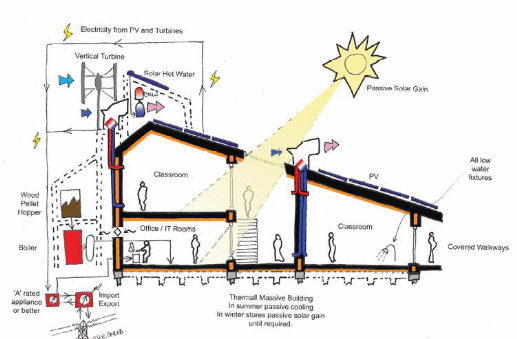
In Figure 1.1, the orientation of the house is east-west such that sun rays are continually fed directly into the rooms to warm or provide light. Equally, water in the stanchion above the building is heated using sunenergy and then distributed to the entire unit. The benefits of these are that there is reduced cost, less usage of machanical processes, as well as the provision of more clinically accepted enviromental conditions for the occupants.
There are however hazards associated with certain roof harvested rainwater as it has been noted by Vasudevan:
Although some rooftop materials may produce rainwater that is harmful to human health, it can be useful in flushing toilets, washing clothes, watering the garden and washing cars; these uses alone halve the amount of water used by a typical home (Vasudevan 18).
Rainwater harvesting techniques vary in terms of complexity based on the application or purpose they are meant to serve. But generally, the total rain that can be harvested at a given zone is a function of the effectiveness of the harvester, the harvesting plane, and rainfall-intensity (which could be defined as the annual precipitation (mm/annum) by the catchment-area [m3] = litres/annum-yield).
Advantages in Urban Areas
A number of advantages are known of harvest of rain, including the following:
- It assures an independent water supply during water restrictions that is though somewhat dependent on end use and maintenance;
- It is usually of acceptable quality for household needs; and
- It is renewable at acceptable volumes despite forecast climate change (Frasier et. al. 57; Pachpute 131).
Hemenway has also noted that:
‘It produces beneficial externalities by reducing peak storm water runoff and processing costs’ (Hemenway 10).
Figure 1.2 Illustrates the process of rainwater harvesting and components of rainwater harvesting system.
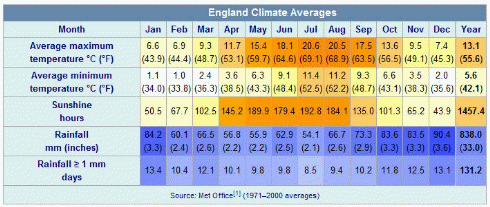
Aim of the Work
The aim of this project work is to design a prototype system that would regard the alternative sources of water, and the ways in which these sources can be used. From table 1, considering the fact that the average yearly precipitation in England is close to 850-900 mm (Gould and Erik 12; Lowes 76; Pachpute et. al 109), rainwater may be regarded as an alternative source of spring water either in terms of been potable or non-potable. The actual importance of this alternative is explained by water contamination, as well as by drying of rivers and lakes.
For the purpose of this design, the most obvious use of collected water is toilet flushes, irrigational purpose, and esthetics enhancement. In general, water quality requirements for flushes are minimal, considering the fact that piping systems of potable water and flushing are integrated. However, the amounts of water for flushing are large enough in public places; rainwater may be effectively used for this purposes. In Waterloo Station, the volume of water used for flushing toilets is placed at approximately 21250 liters/day (Ludwig 3; Kinkade-Levario 17; Radlet and Radlet 45).
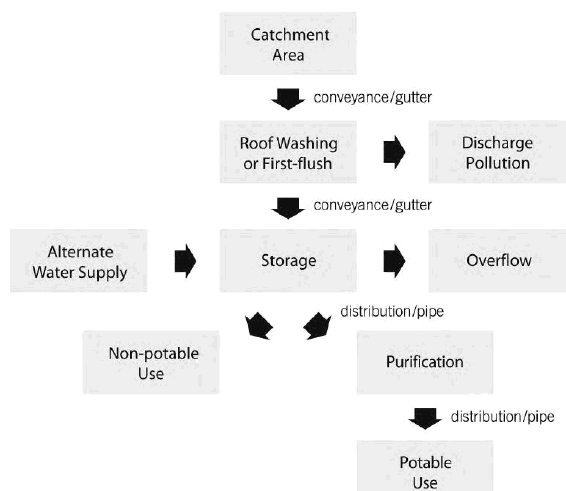
Literature Review
Use of Collected Water for Aesthetic Purpose and Human Health
Harvesting rainwater is a preferred option for collection of water in many cities and villages. In Pornchai Garden in Thailand, rainwater which is being collected on the large railway stations is used for aesthetic and human health purposes. This is achieved by creating a waterfall effect. Most projects associated with rainwater harvesting create waterfalls (Strauss and Swartz 51; UNWWD 120). The Pornchai team built a series of waterways on the roof. When the system is turned on, water is pumped over the sides of the building to create the dramatic waterfall effect. The system is under the complete control of the resort owners. Once the water runs over the side, it is re-circulated back to the top of the feature so the effect is continuous. In fact there are numerous ways of creating a waterfall. Most have their own pros and cons.
From studies conducted by Lawson et.al (43), material that is used for water catching was raincoat 2000 (Pacey and Cullis 18). The used materials is a three-part roof coating product for flat or semi-flat roof that is approved by NSF for potable water harvesting (Krishna et.al 32). According to Strauss and Swartz:
‘Rainwater usage is most effective for the drainage system when it is applied in multi-storey buildings and densely populated districts’ (Strauss and Swartz 54).
It is because the specific roof surface per head is low that the total roof runoff can be consumed. Waterloo railway station may be regarded as a medium density development; where 85% of the rain that falls on the roof might be collected for onsite reuse. When compared to water consumption rate for a typical development of similar size, annual water consumption rate at Kogarah Town Square is approximately 42% less.
Although rooftops are the typical catchment area, patio surfaces, driveways, parking lots, or channeled gullies can also serve as catchment areas. However, because of the higher risk of contamination, storm water collected from ground-level catchment areas should not be used for potable purposes unless a purification system is installed. Rain barn is a term describing an open-air shed designed with a large roof area, the sole purpose of which is to catch rainwater. The structure’s large roof area could also provide shelter for a variety of uses- a patio, carport, hay storage, or farm equipment storage thereby serving multiple functions.
Krishna et.al in their study noted that:
- In a city like Jaipur, it receives an annual average rainfall of about 550 mm i.e.0.55 meter per year. This water is received during an average of 30 rainy days. If rain water harvesting is carried out only during monsoon period, then a maximum of 80 percent can be considered as available for conservation;
- At household level, the total pucca surface area varies from 500 sq. ft. to 5000 sq. ft. For institutions and large buildings, it varies from 2500 sq. ft. to 25000 sq. ft. The surface area available for harvesting varies from as low as 40 percent to as high as 90 percent;
- The rain water harvesting system design based on above two parameters; also include a third parameter that is peak rainfall intensity. This means the maximum rain-water received during one hour. In Jaipur, a maximum of 50 mm of rain water per hour can be considered for the design purpose;
- Generally, flexible pipes can be attached at discharge points on the roof surface to transport water up to the filter (Peters 104; Krishna et.al 59).
Water Stress & Reasons
Demand for clean water is growing quite rapidly in recent times particularly reflecting the worldwide boom in population. Water is used not only for consumption, hygiene, or technical needs. It also servers an aesthetic as well as entertainment function. Water scarcity in England has not so severe though as it is the case in some countries of the world, however, it is stated that for most areas water is available for limited periods, and some regions are featured with lesser water supply per person than in most Mediterranean countries. Where population and demand for water are forecasted to increase, the usage of the finite water resources will grow. Hence, if society hopes to meet the needed economic uplift without over-exploiting the environment, there must be an understanding of how to meet the target of achieving a water sustainable balance between supply/ demand, and the environment through efficient and effective activities (Pachpute 79). This would also be necessary to overcome challenges of water stress.
Water stress relates to the amount of water available per person in a given area; this could entail a present water situation or a forecast situation. When the demand for water is high, there could be a resultant serious level of stress on the available water resources. Figure 2.1 presents the water stress situation in England as at July 2010. However, this situation could vary with seasonal changes such as rainfall which could impact significantly on per capita demand [PCD: which is a reflection of daily water consumption rate] (Gould and Erik 34). Good water usage requires that water dispenser outlets should be shutoff when they are not in use. This is necessary for minimization of waste.
The water saving activity may be performed regardless of the stress levels, as the general requirement of water supply is to reduce the overall water stress. Considering the fact that some regions are drier in comparison with UK, water may be exported. Gould and Erik noted that:
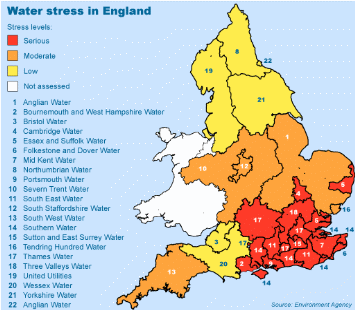
‘With the Industrial Revolution, the size of the cities has grown rapidly. Large amount of water needed and the sewage generated, as well as the increased storm water from the vast urban areas requires a new management approach’ (Gould and Erik 421).
The “Big pipe engineering approach” – for bringing drinking water into the city and for removing wastewater and storm water away from the city has gained acceptance as the standard water management technique in the UK. The resulting centralised system that is now inherit for water management is based on sourcing large quantities of water from one location, adding a number of nutrients to it during its once-only use and finally disposing the waste stream at another point or location.
Scientific and ecological debates associated with origins of water scarcity are mainly deterministic, as the scarcity and stress are generally caused by quite definite reasons, and have quite definite effects. However, if shortage of water is the point that defines the starting of water stress, it infers that sociological and political causes become less definable and forecasted (ESCWA 379). Many of the causes are closely inter-connected.
Education and Water Stress
Water stress education is regarded as one of the most effective ways of water saving. This presupposes teaching the populace to save water resources, take care of the contamination level, as well as the necessity to avoid unreasonable waste of fresh water. Educational measures may involve being acquainted with the water consumption levels and measures taken by countries for saving water resources as well as reducing water consumption.
Considering the importance of educational process in general, it should be emphasized that the most important aspect of education is the water stress in some regions of the world as well as aggravating water situation in the region where education is arranged. Geerts and Raes stress that:
‘Education and awareness in climate change issues should be viewed in terms of acknowledging climate change as an issue and learning the context of this phenomenon which can be referred to as education about climate change’ (Geerts and Raes 45).
However, the greater concern here is about education and awareness for climate change adaptation. It is about the development of adaptive capacity and resilience – increasing the ability of individuals, groups, or organisations toward adapting changes associated with climate change through education and awareness.
This suggests that the actual stress on rainwater harvesting education should be made a necessity for sustainable water management and system development. Equally, there is the need for people to know all the advantages of rainwater harvesting that are linked with eco-friendly habitants, hygiene, public healthcare, and so on. Education also constitutes the necessity to focus on achieving a closed loop in urban water systems. Lessons that should be learned by occupants of an environment are linked with the necessity of water quality improvement and water conservation mechanisms. The interconnectivity between sound education for water management and effective water saving is a reversible balance as illustrated in Figure 2.2 (a) below. Figure 2.2 (b) presents the interconnectivity between regulation, education, water pricing, and incentives involved in water management.

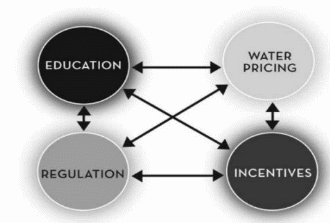
From Figure 2.2 (b), it can be seen that four basic water demand management/ conservation tools are regulation, education, water pricing and financial incentives.
Water and Energy
Water supply systems are among the most energy intensive facilities owned and operated by local governments. This is because electricity is required to collect, treat, and transport the potable water and the wastewater. This energy is responsible for nearly 1% of UK’s annual greenhouse gas emissions. The link between water and carbon is what most people don’t appreciate. It has been noted that:
In considering the process of producing and using water, quite often times, the energy input needed for treating and delivering water to the taps, not to mention the energy used to heat that water for use in the home has been overlooked (Pachpute 79).
Equally, energy and money savings could be achieved also by using the potable water in the right way as there is a waste of expensively processed product. For example in many cases potable water is being used for toilet-flushing. This is a wrong way of using freshwater and alternative water sources could be used for toilet-flushing. A solution therefore is that rainwater should be collection for toilet flushing and other non-potable uses such as watering gardens. Energy which is needed for treatment, conveyance and distribution could be reduced by using rain water harvesting system.
System Evaluation
There is the essence of evaluating the options proposed in terms of quantity and quality requirements. This is necessary for each system and construction cost to be estimated in terms of a fixed cost and other cost that do not change with the operation of the system (such as construction cost), and variable costs that change while the system is operating (such as electricity consumption). Equally, there is the need to consider maintenance of the facility. The following formula is applicable:
- Total cost = fixed cost + variable cost
The costs for the project are presented inexpressively in table 2 below:

The field cost for the construction of the storage thank is placed at 800 £, the cost of electrical devices is placed at 150 £ (this includes the cost of buying the pump), and then the cost of the solar system is placed at 300 £. The entire system would consume 80 watts. With an estimated lifespan of 10 years; these costs are assumed economical for the project. Merits and demerits of the 4 operating options are shown in Table 3.

These are quantitative factors of the 4 options and the ways that would be implemented or operated. The evaluation must also meet the specification of the project. The need of continuous drops for at least 18 hours excludes option 1; even though this option has the higher score. Option 3 has the lowest score but it will be financially evaluated in terms of Percent value analysis (Pw). It is worth noting that the cost is the additional cost excluding maintenance.
The cost of the labour to enhance men to the steel construction could be averagely high. Equally, the cost for derrick, isolation of the tank that includes sound and frost isolation, maintenance access ladder and safety rail, inconvenience of public transportation and complicated pipe system are notable. For the structural enhancement, a civil engineering approach could be adopted for the existing strength of shingle.
On the other hand, the implementation of system 3 and 4 is less complicated; because these have a small cost of devices and small cost of installation. The solar systems are easy to connect and operate with these options, as well.
Water Management and Energy
Water supply systems are among the most energy-intensive facilities owned and operated by local governments because money and energy are required for water supply. It is noted that:
In general the cost of water supply ranges from £0.10 to £0.50 per cubic meter, while the cost of wastewater collection and treatment ranges from £0.25 to £0.5 per cubic meter. Normally, wastewater services cost twice as much as water supply services. In some cases, the cost of water may reach £5 per cubic meter if it is sold by vendors. Because of these relatively high rates, leakage or customer abuse leads to real economic costs (Stubbs 77).
Stubbs further noted that:
Reducing losses from 50 percent to 15 percent and cutting demand in half through water conservation practices can produce net water saving for a city of 400,000 inhabitants of around 71 percent. This is equivalent to about 61.8×106 cubic meters of water per year; this means that another city of about 1 million inhabitants may be served at the same cost (89).
Similarly, if one assumes that an urban water supply and sewerage system consumes energy of 2.0 Kilowatt-hours per cubic meter per supplied water, annual urban energy consumption will decline from 175 gig watt hours to 52 gig watt hours. Annual energy savings would total 123 gig watt hours, which is sufficient to supply a city of more than 120,000 inhabitants with 1,000kilowatt hours per capita per year. This electricity savings would also cut carbon dioxide emissions by 307,000tons per year (Krishna et.al 453). The energy is responsible for nearly 1% of UK’s annual greenhouse gas emissions (Frasier et. al. 78; Hemenway 21).
Materials and Method
Materials
The materials for the design include:
‘’Exposed’’ downpipes and Gutters
The gutters and the downpipes can usually be constructed from a variety of materials, including cast iron, lead, zinc, galvanized steel, painted steel, copper, painted aluminum, PVC (and other plastics [please, kindly find appendix for various sizes of pipes]), concrete, stone, and wood. Another option is that gutters and downpipes could be made of polycarbonate clear plastic. This will enable people to see how the water as it flows; however, if the main aim is to make it visual and attractive, a colouring agent should be used (James 76). The water fills the gutters and then it is pumped in a water tank through the pipes;
Water Tanks
The water tank could be placed outside of the building and people could see the entire flow path of the water through the transparent gutters and downpipes;
Water meter
A transparent tube could be connected with the water tank to enable an easy reading of the water level;
Floating balls or floating sensor
In order to avoid overflow, a floating sensor may be placed in a tank. This will help to control the water level in the tank;
First flushing Devices
Fitting an appropriately sized First-Flush-Water Diverter is critical to achieve good quality water. Water Diverters improve water quality and reduce tank maintenance;
Downspout Filters
Downspout filters provide a second choice to capturing debris that might enter to rainwater storage (James 79). The water through the gutters and the downpipes could be seen through the pipes that guide the water into the water cistern. So it could be easy to observe how the rainwater which would be collected. Figure 3.1 below presents the various components of the prototype design:

Other components that could be used with the design include: Roof Washing System/Pre-storage Treatment; Gutter Guards; Leaf Screens; First-Flush Diverters; Roof Washers; and Conveyance System- few of these are explained below.
Rainwater Water Tanks
One of the most vital components of the design is the water tank. The rainwater amount to be used for toilet flushes depends also on the volume of the water tank. But a design could incorporate the use of several tanks which could be connected together; just as it is the situation at the Makurdi Water Works (Schemenauer et. al 231; Ziegler 305). The number and the size of water tanks depend on the available space at the station, and on the rainwater amount. Water tank application parameters include the general design of the tank, its materials of construction, as well as the following:
- Location of the water tank (indoors, outdoors, above ground or underground);
- Volume of water tank will need to hold;
- What the water will be used for;
- Pressure requirements, domestic pressures range from 35-60 PSI; and
- How the water is to be delivered into and extracted, pumped out of the water tank.
Various materials are used for making a water tank including plastics, fiberglass, concrete, stone, and steel (LIDC 25; Kinkade-Levario 76; Radlet and Radlet 108).
Each of these materials has advantages and disadvantages, particularly when it comes to environmental impact. The cost of the tank is an important consideration, but most importantly is the durability of the tanks before there could be the need for replacement.
The rainwater could also be stored in separate tanks and could be used for other uses like buses washing and irrigation; depending on the available space which each station has.
Sand filters
A Sand filter is necessary for removing turbidity and other toxicants. Ordinarily, sand filters comprise of three layers; a top layer consisting of coarse-sand underlined by a graveled- layer, and pebbled-layer (Figure 3.2).
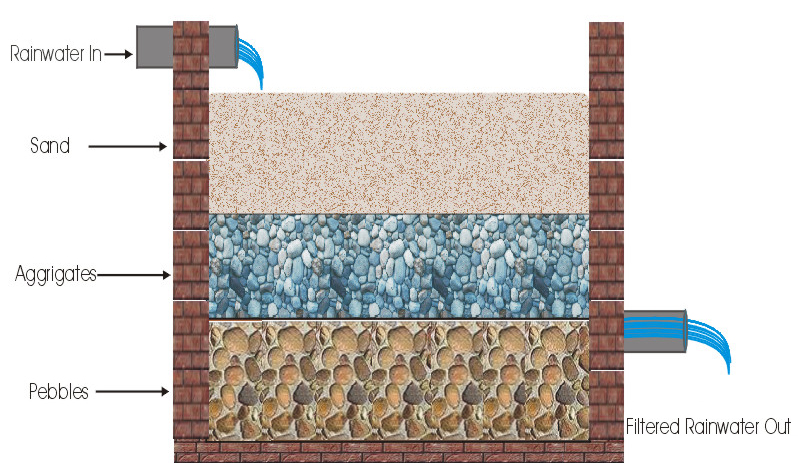
Alternatively, floating fine-suction filters are used in making sure that water pumped is clean.
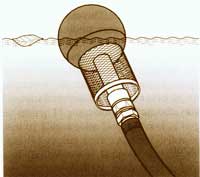
Method
Option 1
Waterfall effect may be achieved in a natural way, in the case of a rainfall. This method is particularly applicable to tropic regions with extensive rains. The rainwater fills the gutter and then this water reaches a downspout, and then falls into a water cistern creating a waterfall effect. As an option, downspouts may be removed, and installation kits may be installed. For creating an effective waterfall effect, the pipes are generally replaced with rain chains or rain cups which control the water flow. Holes may be designed in the gutters for improving the attractiveness of the waterfall effect. However, this option may be reliable and effective only when the gutter is fully felt with the rainwater – based on this reason, another option is comparatively necessary.
Option 2
Water tanks may be placed in different levels. In this case, the water tank could be placed in an upper level and through pipes the water could fill the gutters, follow the option 1 and have a waterfall effect. This option is based on the application of gravity. On the other hand, there is a need for an extra water tank installation in the upper level and for extra pipes (there are water tanks on the ground level which collect water for toilet flushes). Additionally there is a need of materials which are going to be used to hold up the water tank because there is a high pressure.
However, a disadvantage of this option is that the better location of the water tank is on the ground level of the building as the prototype is related to education purpose and the rainwater harvesting system elements have to be exposed in a way which people can watch them. There is therefore a third option which could be preferred to the earlier two.
Option 3
In option 3, rainwater is stored in tanks and is being used for toilet flushes. Part of the water, which is stored in the water-tanks, may be used for the waterfall creation. Decorative water cistern could be filled by the water tank through pipes when it does not rain and the cistern is empty. The water is re-circulated into the cistern and pumped to the top of the structure through pumps and pipes again and again. The amount of the water in the cistern and the height of the roof are quite small and for this reason the pump does not need much electricity. Additionally the pump can work only when it doesn’t rain. The appearance of the outlay of the design is shown in Figure 3.4 below.
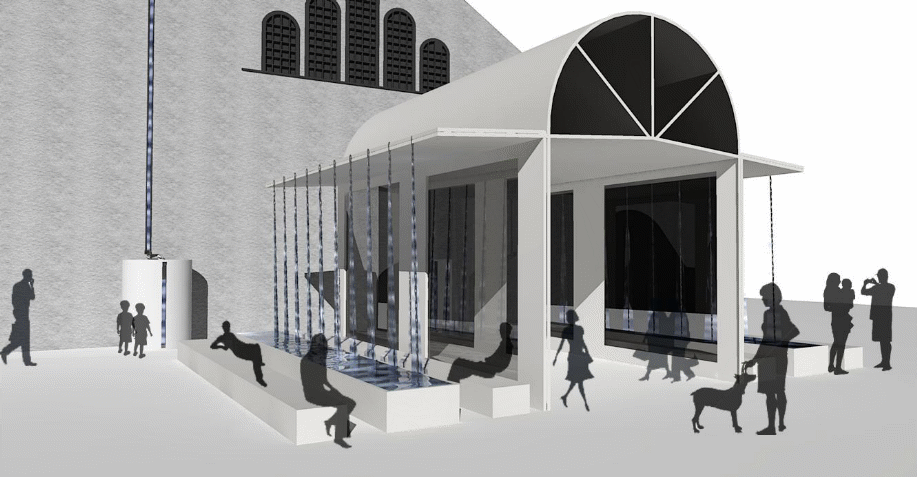
Option 3 is considered for use in the prototype for generation of the required waterfall creation. The choice of Option 3 against Option 1 and Option 2 is because option 1 works only when there is availability of rain, and option 2 needs extra installations and that means extra energy and costs.
Rainwater Harvesting System
Rainwater collection has been regarded as the most effective way of water saving regardless of the overall climate of a region (Esgate and Groome 67). Chang et. al (184) argued that this may help to reduce water consumption from other sources. In accordance with Despins (97) and Lowes (23), two types of using rainwater are known: upstream is aimed at reducing demand for developing the off-site water supplies, and downstream that protects water quality and quantity from excess urban runoff. The technology and its applications are expanding and being refined. Its applicability to both arid and humid climates is becoming increasingly clear.
Studies conducted by ESCWA (203) reviewed that rainwater harvesting consists of up to six primary components depending on the water quality required. These components include catchment, conveyance, filtration, storage, distribution, and purification. The amount of water collected depends on numerous factors such as roof or surface area, porosity, as well as slope angle. Regardless of the catchment surface, a loss from 10 to 70 percents of total water may be expected. This is explained by material absorption or filtering, as well as by possible evaporation. One of the most important aspects is the inefficiency of the harvesting process.
It may be a roof or impervious pavement and may include landscaped areas. Rooftop rainwater catchment is considerably the most accepted technology for harvesting rain; this is because it offers a simpler and cheaper way of harvesting rain. Considering the fact that most roofs are equipped with sewerage systems, the basic technology for rainwater collection is the barrel that catches water from the gutter. The overall surface, as well as the type of material used defines the potential quantity of water collection.
Conveyance systems are the channels of pipes that connect catchment system with tank, and tank with pumping as well as consumption system. It may end with service box for toilet flush, with stopcock, watering hose etc.
The storage system is the tank that is used for collecting and storing water. Tanks may be of various size and material, depending on environmental conditions of the area, as well as the location of the tank: if a tank is located underground, it may be built of concrete, while tanks that are above ground are usually smaller, and made of lighter materials.
Washing systems may be applied for rooftop catchment systems. This is required for cleaning the roof from dust and possible pollutants before harvesting water. These are often called the first-flush devices. Purification includes filtering equipment, distillation and additive to settle, filter, and disinfect the collected rainwater and is only required for potable systems.
Results and Discussion
Analysis
Water Pressure Evaluation
There is great need for the evaluation of the pressure of the water as it flows in the pipes; this is based on the fact that pipes do usually have minor leakages where there could possibly occur a drop in pressure of the fluid as it is circled and recycled in the pipes; this determined pressure would also indicate the possible maximum water-rate that could be allowed in the pipes. The following formula is applicable in determining the pressure as necessary:
QL= N x D x P1/2 .
Where:
- QL = the allowable leakage, L/h (gal/h)
- N = number of joints in length of the main tested
- D = pipe diameter, mm (in.)
- P = test pressure, kPa (psi)
C = a constant which is based on preferred units for use; when SI metric units are the preferred option, then C = 32, 600 (but for U.S. Customary units, C = 1850)
For the designed prototype water harvester, there would be the need to conduct a test in the pipes after the installation is completed- this test would be carried out at 1000 kPa for a period of one hour. In a situation where there could exist any leakages, there would be a pumping of into the pipes to attain a level of repair after which the system would be considered as been fit for usage.
Pump Efficiency and Power
A majority of pumps used in pumping water are electrically driven, but gasoline or alternative fuels could be made use of as well. Whatever energy source may be made use of, it is practically impossible to attain a hundred percent efficiency. The following is used in the determination of pump efficiency as it is applicable to water pumping:
Efficiency = Pout x 100 Pin
When SI Units are applied, the expression of the outcome is in kilowatts. The output power is determined through:
Pout = 9.8 x Q x TDH
Where Q = the pump discharge, m3/s; and TDH = total dynamic head, m
Considering an instance whereby the systems arrangement is such that the pump is located above the water-level on a suction side, there would be a static-suction lift.
Discussion
The educational value of the project involves installing first flushing devices, water meters, tanks, water cistern and so on. One of the most interesting projects dedicated to rainwater harvesting was arranged in Belonie School with assistance by Seychelles-Civil-Association-Authority (SCAA) and School-Environment-Representatives in 2009. Kids were taught to collect rainwater and use it for technical needs. School water bills have been monitored, and the actual importance of this project is explained by the fact that schools managed to save water, decrease its expenses and teach children to treat water resources carefully.
People should be intimated on rainwater harvesting and its help in reducing water bills, as well as in solving water stress problem. This would reduce demand for municipal water supply, as well as the credibility of erosion, flood or contamination of natural water resources (Beh et.al 331).
As for the opportunities of community education, it should be emphasized that the most obvious opportunity associated with training procedures is closely linked with the necessity to show people benefits of using rainwater harvesting. The simplest way is to show people real numbers. It has been already shown that railway stations have an opportunity to save thousands cubic metres of water for toilet flushes by using harvested water. Actually, the same practice may be performed for household purposes.
Assuming that £ 2.53 is paid for water sewerage, up to £ 210 may be saved annually. In average, 0.5 to 1 cubic meter tank will be needed for rainwater harvesting. If the maximal cost is £ 60, the system will be repaid for less then a year. If the entire household will use rainwater harvesting system, tank required may cost up to £ 500.
Conclusion and Suggestions
Conclusion
In conclusion, rainwater harvesting may be used for various purposes. This paper emphasizes the opportunity of collecting rainwater through the usage of roofs as collecting panels. This water could be used for technical purposes, educational purpose, aesthetics, and for improvement of a healthy living; where water could be used to ensure hygiene and as a place for relaxation which could reduce stress (and possibly anxiety) in individuals. An amount of the water which is collected could be used for the waterfall effect creation.
The paper also present the opinion that harvested rainwater could be used for washing buses and irrigation – This would be economically cost-friendly as may be compared to sourcing water for these purposes from other sources.
The key aspect of rainwater harvesting described in the report presents the opportunity of improving the water stress situations which has been aggravating in recent years.
It is also stated that:
‘waterfalls effectively reduce the level of office noise distraction by introducing soothing “white noise” to mask other, more disruptive sounds’ (Esgate and Groome 313; Pachpute 415).
Regardless of the nature of water sound, whether it is a roaring stream or raindrops, this creates a peaceful mood and the sense of unification with nature. Sounds of water make people relax, and create oasis of tranquility, calmness, and can as well help decrease the effects from unpleasant noises from surrounding environment.
Considering the fact that urban environment is reach with noises of various sort; water sources could therefore be an effective counter measure for improving the atmosphere.
Suggestions
The prototype offers a lot of benefits. Water could be used in an interactive way to enhance the well-being of people who use the railway underground stations. As a rule, people who use underground stations need time to relax during the day, as most of them use subways for getting to work and back; hence, they are likely to develop stress and anger as the most common workplace problems. It is stated that people who have an opportunity to view natural sceneries, or something similar, experienced a more effective blood pressure decrease after concentrating at the scenery in comparison with those who did not have an opportunity to view such scenes (Shola and Nike 178). These findings are aimed at indicating how flowing water impacts various living organisms including plants, animals and humans.
On a general note harvesting rainwater for home or public usage is cost and health friendly and should be adopted especially to improve people’s well-being.
Works Cited
Beh, Daniels Frank, et.al. 75% schematic design report; Schematic Report. Univercity of British Columbia: Vancouver, 2010. Print
Chang, Mary, et. al. Roofing as a source of non-point water pollution. Canada: New Society Publishers, 2004. Print.
Despins, C. Ontario Guidelines for Residential Rainwater Harvesting Systems, First Edition. Canada: Heights and High, 2010. Print.
ESCWA (Economic and Social Commission for Western Asia). Water Scarcity in the Arab World. New York: United Nations, 2003. Print.
Esgate, A, and Groome D. An Introduction to Applied Cognitive Psychology. Hove, England: Psychology Press, 2005. Print.
Frasier, Gary, et. al. Water harvesting. Washington D.C.: U.S. Dept. of Agriculture, Agricultural Research Service, 1983. Print.
Geerts, S., and Raes D. Deficit irrigation as an on-farm strategy to maximize crop water productivity in dry areas. London: Water Manage, 2009. Print.
Gould, John, and Erik Nissen-Peterson. Rainwater Catchment Systems. UK: Intermediate Technology Publications, 1999. Print.
Heather, Kinkade-Levario. Design for Water: Rainwater Harvesting, Stormwater Catchment, and Alternate Water Reuse. New York: New Society Publishers, 2007. Print.
Hemenway, Toby. Gaia’s Garden: A Guide to Home-Scale Permaculture. Vermont: Chelsea Green Publishing Company, 2000. Print.
James, J. Rainwater Harvesting Technology in the UK. UK: Intermediate Technology Publications, 1996. Print.
Kinkade-Levario, H. Design for Water: Rainwater Harvesting, Stormwater Catchment, and Alternate Water Reuse. Gabriola Island, BC, Canada: New Society Publishers, 2007. Print.
Krishna, Harry, et.al. The Texas Manual on Rainwater Harvesting. Texas: Austin, 2005. Print.
Lawson, S, et.al. Virginia Rainwater Harvesting Manual., Virginia: Cabell Brand Center, 2009. Print.
LIDC (Low Impact Development Center). Managing Wet Weather with Green Infrastructure. United States of America: Environmental Protection Agency, 2008. Print.
Lowes, P. The Water Decade: Half Time. In in John Pickford (ed.). Developing World Water. London: Grosvenor Press International, 1987. Print.
Ludwig, Art. Create an Oasis With Greywater: Choosing, Building, and Using Greywater Systems. California: Oasis Design, 1994. Print.
Pacey, Arnold, and Adrian Cullis. Rainwater Harvesting. UK: Intermediate Technology Publications, 1986. Print.
Pachpute J. A package of water management practices for sustainable growth and improved production of vegetable crop in labour and water scarce Sub-Saharan Africa. London: Macmillan, 2010. Print.
Pachpute, J., et. al. Sustainability of Rainwater Harvesting Systems in Rural Catchment of Sub-Saharan Africa. London: Macmillan, 2009. Print.
Peters, G. Using Rainwater Effectively. UK: Intermediate Technology Publications, 2000. Print.
Radlet, J, and Radlet P. Rainwater harvesting design and installation workshop. Boerne (TX): Save the Rain, 2004. Print.
Schemenauer, Robert, et. al. Fog Water Collection Manual. Canepa: Thornhill, Ontario, 2005. Print.
Shivakumar, A. Amruthavarshini – A Guide for Rainwater Harvesting. Karnataka State Council for Science and Technology. Bangalore: Indian Institute of Science, 2005. Print.
Shola, Papana, and Nike Lano. Harvesting Rainwater in Igomale. Ibadan: University Press, 2000. Print.
Strauss, A, and Swartz J. The Professional Scientist: A Study of American Chemists. Chicago: Aldine De Gruyter, 2001. Print.
Stubbs, D. Rainwater Harvesting on the Gulf Islands Guide for Regulating the Installation of Rainwater Harvesting Systems– Potable and Non-Potable Uses. Spring Island, BC: The Islands Trust Fund, 2006. Print.
UNWWD (The United Nations World Water Development). Water for People, Water for Life: A Joint Report by the Twenty Three UN Agencies Concerned with Freshwater. New York: Berghahn Books, 2003. Print.
Vasudevan, L. A study of biological contaminants in rainwater collected from rooftops in Bryan and College Station, Texas. College Station (TX): Texas A&M University, 2002. Print.
Ziegler, R. The politics of operationalisation: sustainable development and the eco- space approach. New York: Gan and Sons, 2009. Print.
Appendix
Sizing of rainwater pipe for roof drainage (mm/ h – millimeters per hour; m – meters)
Pictures
